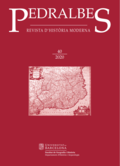Hidden subjectivities in objective measures: Spanish perceptions of geographic space in North Africa
Keywords:
Spanish Empire, North Africa, cartography, perception, space.Abstract
In the late fifteenth and early sixteenth centuries, Spanish forces invaded a number of coastal towns in North Africa. Historians often consider this en-counter as a continuation of a familiar context of Christian-Muslim relations in the western Mediterranean. As such, Spaniards are presumed to have al-most had a pre-knowledge of topography that resembled Iberian landscapes and of climates, flora, and fauna that nestle comfortingly within a Braudelian belt of olive trees. How well does this characterization indicate Spanish sen-sory perceptions of the geographic world of North Africa? Geographic knowl-edge was critical for the military campaigns that sought to capture overseas territories and the gathering and representing of information overlapped with developing sciences, including engineering. Representations of such data fix-ated on precise measurements. At the same time, human experience of meas-urable quantities such as distance were conditioned by subjectivities. Human agency, sensory perception, and even imaginaries of the unknown all altered how the Spaniards encountered the geographic world of North Africa. By juxtaposing geographic perception in measurable and subjective terms, this article presents another side of Spaniards’ encounters with North Africa.
Downloads
Published
How to Cite
Issue
Section
License
Copyright (c) 2020 Yuen-Gen Liang

This work is licensed under a Creative Commons Attribution-ShareAlike 4.0 International License.
Authors must agree with the following terms:
1. The author keeps authorship rights, ceding the journal the right to first publication.
2. Texts will be disseminated with a Creative Commons Attribution 4.0 International License. Which allows for the work to be shared with third parties, as long as they recognise the work’s authorship, the original publication in the journal and licensing conditions.
This requires acknowledging authorship appropriately, providing a link to the license, and indicating if any changes have been made. It can be indicated in any reasonable way, but not in a manner that suggests the licensor endorses or sponsors the use of the text.
If content is remixed, transformed, or new content is created from the journal's texts, it must be distributed under the same license as the original text



